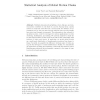Free Online Productivity Tools
i2Speak
i2Symbol
i2OCR
iTex2Img
iWeb2Print
iWeb2Shot
i2Type
iPdf2Split
iPdf2Merge
i2Bopomofo
i2Arabic
i2Style
i2Image
i2PDF
iLatex2Rtf
Sci2ools
ECCV
2008
Springer
2008
Springer
Statistical Analysis of Global Motion Chains
Abstract. Multiple elements such as lighting, colors, dialogue, and camera motion contribute to the style of a movie. Among them, camera motion is commonly overlooked yet a crucial point. For instance, documentaries tend to use long smooth pans whereas action movies usually have short and dynamic movements. This information, also referred to as global motion, could be leveraged by various applications in video clustering, stabilization, and editing. We perform analyses to study the in-class characteristics of these motions as well as their relationship with motions of other movie types. In particular, we model global motion as a multi-scale distribution of transformation matrices from frame to frame. Secondly, we quantify the difference between pairs of videos using the KL-divergence of these distributions. Finally, we demonstrate an application modeling and clustering commercial and amateur videos. Experiments performed show advantage compared to the usage of some local motion-based a...
Camera Motion | Computer Vision | ECCV 2008 | Global Motion | Local Motion-based Approaches | Long Smooth Pans | Video Clustering |
| Added | 15 Oct 2009 |
| Updated | 15 Oct 2009 |
| Type | Conference |
| Year | 2008 |
| Where | ECCV |
| Authors | Jenny Yuen, Yasuyuki Matsushita |
Comments (0)

